In spite of the title of this log entry, our path hasn’t been so much a straight line across the country as a multi-jointed dog leg. The dual needs of warmer weather and time to focus on work have been skirmishing for dominance, both occasionally pushed aside while we enjoy our surroundings.
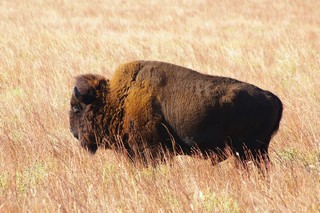 Wichita Mountains Wildlife Refuge
in Oklahoma is our first such stop. We were here
back in 2004 and so I
won’t repeat myself. What is most striking this time around is the very
real sense that the refuge is at a transition point from east to west.
We’ve been driving across the farmed flatlands of the Midwest for days and
arriving here is the first real glimpse of hills, rocky outcrops and open
range brought together in a familiar tableau. It suddenly feels like the
West, and the large mammals wandering the yellow grasslands only add to this
impression.
Wichita Mountains Wildlife Refuge
in Oklahoma is our first such stop. We were here
back in 2004 and so I
won’t repeat myself. What is most striking this time around is the very
real sense that the refuge is at a transition point from east to west.
We’ve been driving across the farmed flatlands of the Midwest for days and
arriving here is the first real glimpse of hills, rocky outcrops and open
range brought together in a familiar tableau. It suddenly feels like the
West, and the large mammals wandering the yellow grasslands only add to this
impression.
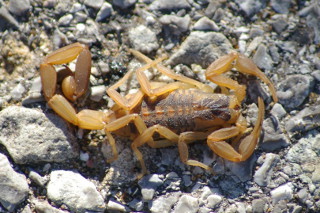 In the morning we find a very interesting but much
smaller creature hiding amongst our leveling blocks. It’s a scorpion but
only just; it’s less than an inch long. The cold morning air makes it
disinclined to move, the weak sunlight bringing a translucence to legs and
tail, the patterns on the carapace clearly visible. The tail remains at
rest; either we’re no threat or it’s too cold for such energetic
posturings. It strikes me that the scorpion is always portrayed as one of
the threats of the desert west, with a potentially lethal sting and a hint
of bad temper leading to unprovoked attacks of innocent people. Reading
about these fascinating creatures, the truth appears somewhat different
with very few posing a serious danger although that’s not to say you won’t
know about it if you are stung.
In the morning we find a very interesting but much
smaller creature hiding amongst our leveling blocks. It’s a scorpion but
only just; it’s less than an inch long. The cold morning air makes it
disinclined to move, the weak sunlight bringing a translucence to legs and
tail, the patterns on the carapace clearly visible. The tail remains at
rest; either we’re no threat or it’s too cold for such energetic
posturings. It strikes me that the scorpion is always portrayed as one of
the threats of the desert west, with a potentially lethal sting and a hint
of bad temper leading to unprovoked attacks of innocent people. Reading
about these fascinating creatures, the truth appears somewhat different
with very few posing a serious danger although that’s not to say you won’t
know about it if you are stung.
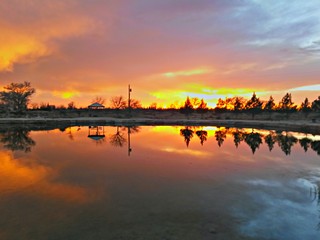 Back on the dog leg, we arrive in New Mexico and
settle in near Artesia for a solid block of work before heading northeast
to Oasis State Park. The vast expanse of high plain in eastern New Mexico
is known as the Llano Estacado and while there is much debate about the
origin of the name its flatness cannot be disputed. The park sits at an
elevation of four thousand feet, its dry-looking grassland and dunes
surrounding a small pond and given its name you would be forgiven for
thinking that the lake is the oasis in question. A cursory look quickly
undermines that view; the water is clearly contained by an artificial wall
and further reading reveals that it was created in 1972 and lined with
bentonite clay. Whatever its provenance it is incredibly popular with the
locals, who are attracted by the trout and catfish with which the water is
stocked. A few short trails meander around the dunes and at sunset the sky
illuminates in a startling array of colour, one of the most dramatic such
displays we’ve seen in a long time.
Back on the dog leg, we arrive in New Mexico and
settle in near Artesia for a solid block of work before heading northeast
to Oasis State Park. The vast expanse of high plain in eastern New Mexico
is known as the Llano Estacado and while there is much debate about the
origin of the name its flatness cannot be disputed. The park sits at an
elevation of four thousand feet, its dry-looking grassland and dunes
surrounding a small pond and given its name you would be forgiven for
thinking that the lake is the oasis in question. A cursory look quickly
undermines that view; the water is clearly contained by an artificial wall
and further reading reveals that it was created in 1972 and lined with
bentonite clay. Whatever its provenance it is incredibly popular with the
locals, who are attracted by the trout and catfish with which the water is
stocked. A few short trails meander around the dunes and at sunset the sky
illuminates in a startling array of colour, one of the most dramatic such
displays we’ve seen in a long time.
We have come to this slightly nondescript park because of its
proximity to the Blackwater Draw archeological site. Our interest was
piqued by having read the fascinating book
1491 by Charles C Mann in which he
presents evidence of a much earlier human presence, higher population
density, as well as social and cultural development in the pre-Columbian
Americas than is commonly believed. The initial piece in this
archeological puzzle was discovered at what is commonly known as “The
Clovis Site” or more properly, Blackwater
Locality No. 1.
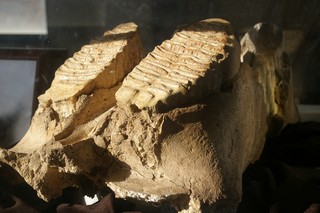 The importance and significance of the location is clear both from the
on-going work over eighty years following the initial excavation and from the
fact that the site gave its name to the “oldest accepted widespread
culture in the New World”.
The importance and significance of the location is clear both from the
on-going work over eighty years following the initial excavation and from the
fact that the site gave its name to the “oldest accepted widespread
culture in the New World”.
Evidence of human hunting at this site, including stone arrow heads and marks of butchering on bison and mammoth bones, date the earliest human activity here to around thirteen thousand years ago when a spring fed lake attracted animals and humans alike. The site is closed for the season but we manage to arrange to visit and are met by one of the graduate students, an incredibly friendly and informative woman who shows us around the small visitor centre. The bones are enormous and put into perspective the courage needed to face these animals armed only with arrows and spears.
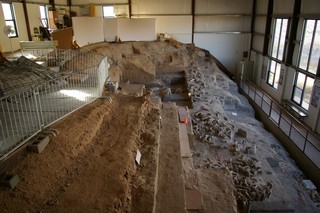 We set off on the short self-guided tour of
the site and although we know the significance of the place much of the
walk is of little obvious interest. This changes when we arrive at a large
building erected to protect an amazing density of pleistocene animal
bones. The hillside covered by the shed has been terraced, the excavations
revealing various clusters of skeletons in situ. It reminds us of a
similar display at
Dinosaur National Monument
although admittedly those bones are another order of magnitude larger (and several orders older).
We set off on the short self-guided tour of
the site and although we know the significance of the place much of the
walk is of little obvious interest. This changes when we arrive at a large
building erected to protect an amazing density of pleistocene animal
bones. The hillside covered by the shed has been terraced, the excavations
revealing various clusters of skeletons in situ. It reminds us of a
similar display at
Dinosaur National Monument
although admittedly those bones are another order of magnitude larger (and several orders older).
From The Bones we move on to
The
Devil’s Inkwell at
Bottomless Lakes
State Park where a
string of sinkholes sit at the base of a small escarpment on the otherwise
flat Llano Estacado. The limestone bluffs are slowly retreating under the
attention of the Pecos River, the lakes the remains of caves previously
encapsulated in the rock, their ceilings long collapsed.
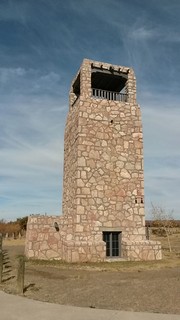 The Inkwell is
named for its steep sides and black looking water, caused I have read by
plants and algae growing on the bottom. After so much flat, it’s a place
of some topographical interest and a wonderful place to spend the night.
The Inkwell is
named for its steep sides and black looking water, caused I have read by
plants and algae growing on the bottom. After so much flat, it’s a place
of some topographical interest and a wonderful place to spend the night.
As with so many places in the West, the CCC have left their stamp here, in this instance in the form of a large bathhouse and pavilion on Lea Lake with a nearby water tower. While still standing, the structures are no longer operational; a ranger tells us that the plumbing has been removed. They are still impressive, their style a strange mix of rustic, mission and CCC. It seems a real shame that they are preserved simply as a monument rather than as a working facility for visitors to enjoy.
Further up the Pecos and with the escarpment still visible is the Bitter Lake National Wildlife Reserve. Sandhill Cranes and Snow Geese arrive here in their thousands during the winter and they are already making their presence felt. Access is limited and although there is a dirt road around the unit and one or two hides, it is difficult to get very close to the main attraction. We’d have to spend a great deal more on our binoculars and camera before we could get a better look and the photos we’d like. In spite of these limitations, huge groups of cranes moving in synchronicity, their long elegant necks repeating the same curve throughout the flock is a sight worth seeing, while the snow geese blanket the water, small groups taking to the wing at the slightest provocation.
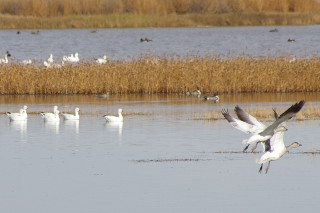 Numerous other species pass through although some stay for only short
periods. The Pintails seem the most obvious currently with their distinct
markings and profile but the Ruddy Ducks that were counted here a couple
of weeks ago have flown the coop, much to my disappointment. I first
encountered these delightful birds in Leicestershire more than thirty five
years ago. Due to their distinctive appearance, they had been introduced
to Britain as ornamentals in the 1940s. From there they spread to the
continent and began cross breeding with the rare and heavily protected
White-headed Duck. In more recent years this hybridization has posed the
biggest threat to the survival of the indigenous European ducks and has
resulted in a
government led cull
aimed at the total eradication of the Ruddy Duck from the UK. It is
another story of human interference gone wrong: introduce a species to a
location where it doesn’t belong, watch in horror as it makes a niche for
itself that often threatens or damages local fauna or flora, and then
attempt to eradicate it. The Ruddy Duck is blameless but the birds pay the
price of someone wanting a few pairs to show off on the lake in their
estate.
Numerous other species pass through although some stay for only short
periods. The Pintails seem the most obvious currently with their distinct
markings and profile but the Ruddy Ducks that were counted here a couple
of weeks ago have flown the coop, much to my disappointment. I first
encountered these delightful birds in Leicestershire more than thirty five
years ago. Due to their distinctive appearance, they had been introduced
to Britain as ornamentals in the 1940s. From there they spread to the
continent and began cross breeding with the rare and heavily protected
White-headed Duck. In more recent years this hybridization has posed the
biggest threat to the survival of the indigenous European ducks and has
resulted in a
government led cull
aimed at the total eradication of the Ruddy Duck from the UK. It is
another story of human interference gone wrong: introduce a species to a
location where it doesn’t belong, watch in horror as it makes a niche for
itself that often threatens or damages local fauna or flora, and then
attempt to eradicate it. The Ruddy Duck is blameless but the birds pay the
price of someone wanting a few pairs to show off on the lake in their
estate.
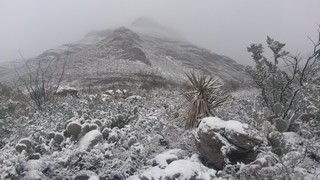 The last stops worth a mention on this
diagonal journey across country are also in New Mexico, not far from
Alamogordo. The first is Oliver Lee Memorial State Park which we have not visited since
2003. The major
differences this time around are the low temperatures and the snow. The
wind whipping across the plain is familiar but its ice cold touch is a
little less comfortable than the springtime balmy breezes that I remember.
The last stops worth a mention on this
diagonal journey across country are also in New Mexico, not far from
Alamogordo. The first is Oliver Lee Memorial State Park which we have not visited since
2003. The major
differences this time around are the low temperatures and the snow. The
wind whipping across the plain is familiar but its ice cold touch is a
little less comfortable than the springtime balmy breezes that I remember.
Being so close, we cannot pass without a visit to White Sands National Park. The recent snow gives the dunes an unusual perspective. The alleged colour of the sand proves to be an illusion under the powdery covering. It reminds us of living in Wales, where the sheep, like the dunes, look white until it snows and their true colour is revealed.
It’s a bright sunny day, the air crisp. This is a place to play and
Sterling thoroughly enjoys recording
his antics through the unique perspective of his latest toy,
Google Glass.
